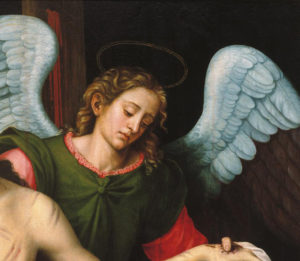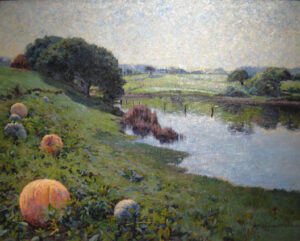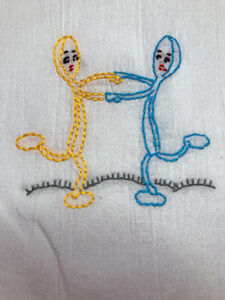
September this week transitions to October. The transition is overseen by shining beings, an abundance of angels, for these are days traditionally given to angels: In three days’ time, on October the 2nd, we celebrate the Feast of the Guardian Angels, and today, the 29th of September, brings the Feast of St. Michael the Archangel––a day better known as Michaelmas.
The one that comes later is more personal, a day set aside to honor our personal guardian angels. It is a very old tradition, one that dates to the Fourth Century, when folks began setting up altars in their homes on the feast in honor of their angelic protectors. And I wonder sometimes about the strange coincidences in life. Like just yesterday at work, while I was looking for something completely unrelated in the closet, I happened upon a pile of sheet music. Where it came from, I could not tell you, but there it was: sheet music for old Italian songs like “O Sole Mio” and “Funiculì, Funiculà” and a traditional Neapolitan Tarantella, and beneath these, a book of old Frank Sinatra tunes. What’s so strange about this? Well, tomorrow my mom and sister and Seth and I: we are heading down to the Fort Lauderdale Historical Society there on the New River to build an ofrenda for the upcoming Day of the Dead festival. The ofrenda we’re building is meant to honor all our family, but especially the musicians, like Grandpa, who taught himself to play guitar and mandolin, and Uncle Phil, who played accordion, and both of Seth’s grandmas, who played piano and organ. But mostly this is about my Aunt Anne, who passed away in July. Aunt Anne traveled the world with the USO during World War II playing accordion for the troops. We’re calling our ofrenda “Thank You for the Music,” and I had gathered some random sheet music to place on the altar––I found some Bach, some Mozart… but none of my family played classical music. They played old Italian folk songs, and they played Frank Sinatra songs. Who placed that sheet music in the closet when we’ve been closed for a year and a half? Has it been there all this time? How did I manage to find it just yesterday? Say what you will about guardian angels… I do feel, very often, well looked after. What if it’s always the same being helping me out? And what if it’s not a human being so much as a shining being?
The shining is handed down through centuries of etymology, and my favorite aspect of these days when we honor the angels around us is the chance to recite a litany of shining names. The feast that comes today––Michaelmas (pronounced mick-il-mus)––begins with Michael the Archangel but has come to honor angels in general. Various traditions across cultures will honor today Michael as well as his other archangel companions, Gabriel and Raphael. Still others will include Uriel, Raguel, Ramiel, and Sariel. I love these names; they roll past my lips in an ancient and mysterious tongue, and the further down the roster we go, the more mysterious the names become. To speak them is to cross a fascinating linguistic bridge to the past. The “-el” suffix of these angelic names is Sumerian in origin, signifying “brightness” or “shining,” names that in their true form would be Micha-el, Gabri-el, Rapha-el, Uri-el, Ragu-el, Rami-el, Sari-el. The list goes on: Camael, Jophiel, Zadkiel, and Anael, Simiel and Oriphiel, then on to Metatron, Israfil, and Malak al-Maut. It is a walk across an ancient bridge of etymology that connects to the Akkadian ilu (radiant one), Babylonian ell (shining one), Old Welsch ellu (shining being), Old Irish aillil (shining), Anglo-Saxon aelf (radiant being), and English elf (shining being).
Michaelmas is traditionally a night for a dinner of roast goose, and afterward, roasted nuts. But it is the humble blackberry that is most traditional for this day: In Scotland, there are Struan Micheil, Michaelmas bannocks, somewhat like a scone but more of a flatbread, cut into wedges, comprised of equal parts oats, barley, and rye, and traditionally made without the use of metal: wooden fork, wooden or ceramic bowl, baking stone. The bannocks are served with blackberries or blackberry jam, for it was Michael the Archangel who battled Satan, the fallen angel, and when Satan fell to Earth, it was in a bramble patch––a blackberry patch––that he landed. Legend has it that each year after Michaelmas, Satan returns to curse and spit upon the brambles that he landed upon, which is not so surprising: Bramble patches are thorny and painful. You’d probably curse and spit upon them, too, if you fell into a bramble patch. Be that as it may, many people will not eat blackberries after Michaelmas for this reason, and so they’ll eat their fill of the plump, juicy berries today.
If you’ve not been in a bramble patch and are wondering why Satan was so infuriated at landing in one, well… I wrote about my experience foraging for blackberries in an essay that was published in 2009 in a magazine called My Table. It’s Houston’s dining magazine. I’m pretty sure it’s ok if I republish it here for you today…. as a Michaelmas gift, if you will.
B L A C K B E R R I E S
The sun is warm, and the blackberries are ripening in Maine. I see them along the roadside each day as I walk past, and today, the call is too alluring. Back home in Florida I’d have to pay three bucks or more for just a half pint tray at Publix, and here, so many wild berries, free for the taking.
Amongst the berries, with my stainless steel colander filling nicely, my mind wanders and I begin to think of blackberry jam, and blackberry pie, and I even wonder about blackberry Jell-O. And I am amazed at how little competition I have. No one else is here. No neighbors, no signs of birds gorging or raccoons foraging. Just branches laden heavy with fruit. And thorns––I notice thorns, though they seem harmless enough.
From the house, I hear a call for lunch. “One minute,” I yell. The colander’s pretty full, but there’s always one more berry I’m after. And there they are, at the deepest edge of the roadside woods: the plumpest berries yet, near bursting with juice. My adrenaline spikes. I make my way carefully through the plants, but still one leg or the other sometimes catches on the brambles. Shorts were probably a bad idea.
The berries are half the size of my thumb and they give gently as I pull and gather them, while the plants, relieved of their heavy burden, spring upwards in the dappled sunlight. I picture myself in a painting by one of the French Impressionists. Surely they painted berry pickers.
There’s a buzzing in my ear, and from the house, another call to lunch, as more plump berries turn up beneath a leafy branch. I lean for them, careful not to spill the contents of the colander, but distraction sets in: My legs are beginning to itch. I look down and notice swarming mosquitoes from the cool woods, the plague of my days in Maine. Torn between swatting and gathering, I attempt to swat one leg with the other as I lean in further for the berries. But as I lean, something tugs at my shirt. It’s the thorns. They’ve got me to where it would be painful to press on or to pull back. I press on. I find the thorns actually have a good enough grip on my shirt that they can support me as I lean in for another handful of berries. But then I lose my footing, slip down a small embankment, while, for better or worse, the thorns still hold their grip, as I cling tightly to the colander.
Finally I do have to pull back. The tugging on my shirt ceases as suddenly as it began as a fierce Velcro sound tears through the sylvan wooded quiet. I tense for a moment, then wonder at the pleasing cool breeze across my left arm. It feels good, but it’s blowing through a new, large gash in my sleeve. The cloth dangles at the elbow, and I realize, too, that my arms and legs are stinging. I make my way out as the bramble patch lays claim to more and more of my clothing and bare skin, and finally stumble out onto the roadside, mosquito-bit and briar-scratched, clutching my colander full of berries.
My neighbor, Mr. Knapp, drives past in his old Ford pickup. He stops, then backs up to where I’m standing. “You all right?” he asks. He is Maine born and bred, a man economical with his words. “I’m ok,” I reply. I manage a nervous smile. Mr. Knapp nods, and the engine sputters as he shifts the truck out of reverse. As he drives off, I think I see him rolling his eyes. I make my way back to the house in the wake of his exhaust. I can taste blood on my lip, and I can almost taste blackberry pie.
Image: Detail from “Christ in the Arms of Two Angels” by Juan de Juanes. Oil on panel, c. 16th century. [Public domain] via Wikimedia Commons.
CHOOSE YOUR SALE!
At our online Convivio Book of Days Catalog, take your choice this week of two sales we are running. First up: Mom is turning 95 on Saturday, and to celebrate, we’re having a sale on her Millie’s Tea Towels line of hand embroidered flour sack tea towels. Save $9.50 when you buy any four of Millie’s Tea Towels (or one 7-day set), and get free domestic shipping, too, when you use the discount code HAPPYBIRTHDAY at checkout. Find Millie’s Tea Towels at the new Linens & Textiles link on our catalog page. Shop here!
Tea towels not your thing? Save $10 on your purchase of $75 on everything in the shop with discount code STREETFAIR, plus get free domestic shipping. Everything means everything! Artesenanías Mexicanas for Dia de Los Muertos, sparkly new Advent calendars from Germany, German and Swedish woodcrafts for Christmas, and lots more. Shop here!



